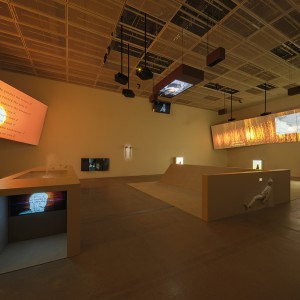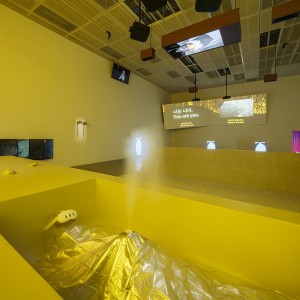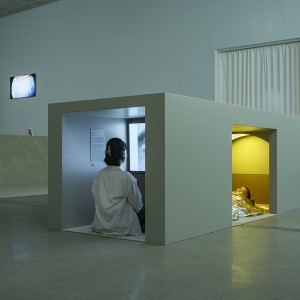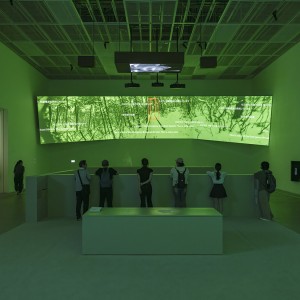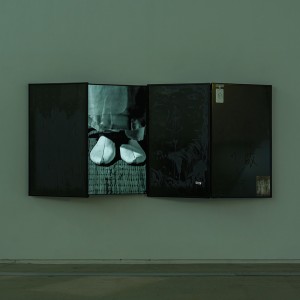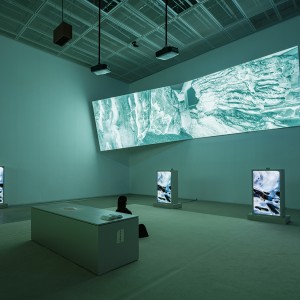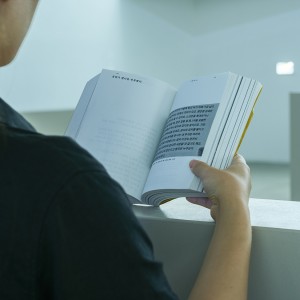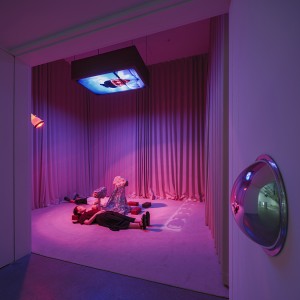Im Youngzoo
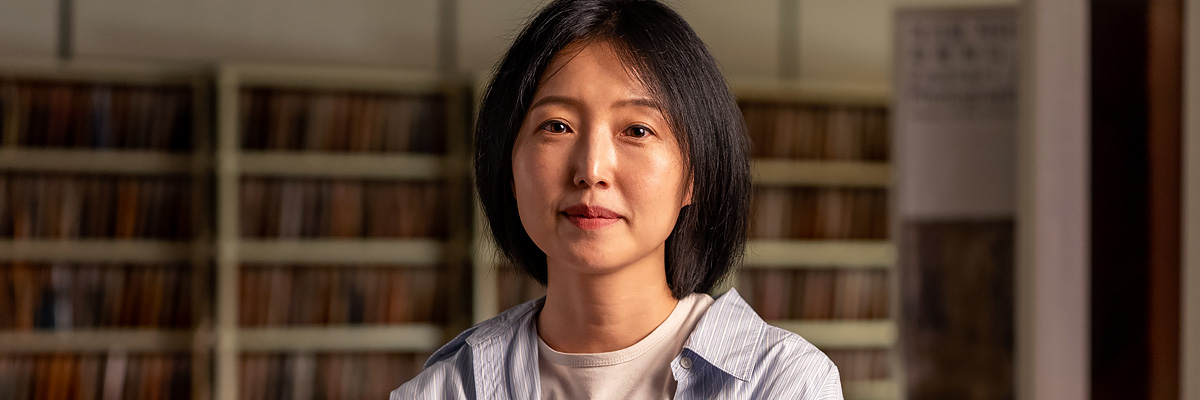
Interview
CV
Tomb of Technology, Site of Sensation, Signal to Come
Kim Haeju
Issued by the National Institute of Korean Language, the Standard Korean Language Dictionary defines “belief” as: 1. trust in a given fact or person, 2. the acceptance of religious doctrines or gods, or transcendent beings as truth. This attitude or mental state of trusting, without doubt, a fact, phenomenon, or system is fundamentally rooted in “emotion,” meaning it is neither tangible nor fixed. When such belief is formed collectively, it becomes culture, and also system, exerting a broad influence on society—including on those who do not necessarily share in said belief itself.
Resisting the confining strictures of any specific religion or ideological framework, Im Youngzoo captures, with a certain delicacy, how “belief” emerges as culture, consumed in the course of daily life. Im’s works to date have regularly incorporated elements from her ongoing exploration of the technical and visual-perceptual mechanisms that lead to such “belief.” Take, for instance, the ambiguities found across religious faith and the language of science, the latter of which tends to be regarded as belonging to the domain of universal fact; weaving them together, Im presents visual specimens of belief. The artist notes: “Once something is placed within the framework of science, it becomes easy to believe; but this process (of belief) is actually much closer to religious faith than the way we engage with things that are unscientific.” In Test_Material (2016), we are presented with close-up footage of a hand touching a stone that is, in turn, being heated by a bunsen burner, looped and overlaid with the sound of something sizzling—a scene that melds scientific experimentation with supernatural experience. In Generally Fair (2017), she fuses meditative visual imagery with sound of the ambiguous expressions often used in weather forecasts, transforming the ostensibly factual nature of the information being presented.
Im Youngzoo is less concerned with “what is being said” than with “what we are made to see and how we are made to believe.” Closely observing the seemingly indiscriminate coexistence of rationality and irrationality in Korean society, often fusing logic and superstition, the artist uses inventive combinations of images to present the structures that shape these scenes. This sensibility is showcased to great effect in her use of video editing techniques: the near-pornographic repetition of close-ups in AEDONG (2018), for example, capturing Chotdaebawi Rock in Korea’s East Sea across different times of day; or the relentless repetition of the line “Do you feel that way, too?” in Mood (2018). As the artist herself puts it, “belief is not certainty, but a state of repeated questioning within the state of uncertainty.” Im understands that repetition of image and sound is a fundamental mechanism that triggers the sensation of belief. We all know from lived experience how the repeated appearance of a certain product in our feed, or the recurrence of fake news as certain people scroll, has led directly to purchasing behaviors and collective fanaticism, respectively. Sudden overlays and splitscreens, the insertion of crisp graphic elements, disaster alarms, echoing voices, and meditative sounds all function as perceptual cues intended to summon belief. The artist actively adopts codes specific to mainstream Korean culture: the shrill disaster warning tone familiar to anyone with a mobile phone; the instantly recognizable National Weather Service jingle that reflexively signals a forecast; the subculture of hobby groups addressing one another by nicknames; and even certain memes that circulate on social media. All familiar triggers designed to evoke certain moods or steer the viewer into a particular emotional or perceptual state. Meanwhile, Im also understands that the typography of Sino-Korean characters evokes the sense of something old, like a folk tale, or at least indicates a degree of solemnity; and that voices with echoing effects signal therapeutic speech patterns and are used in meditative narration. Indeed, when we recognize that the black hair and white dress of the popular “girlfriend shot” meme used in I-HAVE-DONE-THIS-PICTURE The Sky is Blue and I am with You (2018) calls to mind, for Koreans, the figure of a ghost, we realize these elements are all part of a larger visual code that is deeply entangled with familiar superstitious conventions still prevalent in Korean society.
Despite their abundant use of the visual perceptual codes that both shape a society’s collective experience and are themselves produced by the collective culture, these video works refrain from critique or simple parody, resisting the construction of any singular narrative and avoiding resolution. Structured in repetitive loops that cycle back to their starting point, the videos depict hollow, blank spaces, like empty clamshells scattered on the beach; the sound, meanwhile, is sharp, slicing in here and there. Leaping symbols and transitionless scenes appear random, abrupt, even clumsy; but it is a clumsiness executed with enough precision that we can feel its intentionality. Here, the artist’s technique—weaving together various mechanisms used to trigger the sensation of belief in such a way that no such powerful emotion can be evoked—lays bare the illusion at hand through its own emptiness.
This is not to say that social issues and realities are entirely excluded from Im’s work. On the contrary, they regularly serve as specific points of departure, emerging as “objects of belief” that drive a given piece. Notably, however, these events rarely appear within the work as any kind of factual citation; rather, they appear as images in the media that either stand in for the event in question or effectively replace it, becoming a launching pad for other, divergent lines of thought. For instance, in Guest star (2018), a distant press image of the unofficial summit between North and South Korea becomes the starting point for a desire to explore some unnamed object—a desire that eventually detonates into a supernova. In the apocalyptically framed THETA (2019–2020), the artist links the stock market, brainwaves under heightened emotional states, repetitive walking, and deepfakes to a web of longing and fantasy surrounding technology and capital. Through free associative imagery, non-linear sound and editing techniques, and multi-channel installations, the inciting events are unmoored from their original contexts and reconstituted as visualizations of the artist’s swirling, spiraling thought process, as immersive “moods.”
With Human/I (2021), we see a deepening of the artist’s experiment exploring the effects and mechanisms that produce a state of belief, pursued through a multiplicity of medium and form spanning exhibition, performance, book, and website. Im herself states that the impetus for Human/I was “to try and capture this desire for things that allow us to leave our bodies behind, for these illusions—a desire reflected in cutting-edge tech like crypto and VR.” VR, in particular, strikes the artist as a mechanism that reflects a human desire to detach from one’s own body and move outward—which, in turn, reflects an impulse to escape reality. What matters to Im, in all this, is that even in this state of departure or escape, we must hold on to our awareness that we are still seeing only “illusions”; and that one continues, as ever, to gaze upon the body one has left behind, now no more than a shell.
“I studied meditation once, a while ago, and the most important thing I learned was the ‘repetition of awakening and immersion.’ Immersion without awakening is dangerous, and immersion alone doesn’t allow you to go deep. The same can be said of technology—there are moments when it becomes possible to perceive my physical body here in the present while simultaneously detaching my senses, observing the immersed world, and then returning to feel myself again, in this place. I find that point of intersection fascinating, and this continues to shape my work.”
In particular, the use of performance as a medium—performances in which the body becomes the material, the temporal experience of the “present” is foregrounded, and a communal embodiment that includes the audience come together to form an overarching context—is a compelling means of intensifying the exploration of “technology’s out-of-body desire.” Performance, as seen in the “pseudo-VR” experience described later in this text, becomes a method for taking specific spatio-temporal settings and relocating them via pseudo-experiments with technological mechanisms that immerse and awaken. In this piece, the performance is staged with participants gathered in one space, seated in rows to face a single direction—reminiscent of a church or a temple—while experiencing a three-sided video projection. This unfolding scene then becomes source material for a website, where it is rebroadcast as a live online performance. This multilayered structure is used to track the dynamics and feedback loops that emerge when digital technologies such as VR or AI come to be regarded as new objects of belief, as they operate within the framework of that belief.
Waiting M (2021), Calming Signal (2023), LiDAR LiDAR Lead me to my grave (2023), and 미련 未練 Mi-ryeon (2024) are all works produced during this period. During this time, the artist also experienced the death of her maternal grandmother, prompting her to reflect on how the concept of a disembodied world and the afterlife might be manifested as a physical place, and how the function of technology might be presented within that space.
“After briefly paying respects to my grandmother’s portrait at the funeral hall, I went straight to her room. Nothing had been tidied. The heated earth mat on the bed was still warm, as if she’d just stepped out for a moment, and one corner of the blanket was thrown back. I thought I should clean up a bit, so I unplugged the mat and started to put away her clothes—but then I found myself gripping the corner of the blanket and just lying down on the empty space of the bed. The mat warmed my back, and the smell was just as it had always been.”
An empty space that still holds warmth, and scent. This note offers a glimpse into the kind of sensation the artist was holding onto as she prepared for what came next. Below is a text she wrote long before this moment.
“When experiencing some phenomenon, or encountering something, there are things that don’t end with that one moment, things that don’t fall away; there are things that stick to me. If strong belief is simply belief accompanied by will—if it is, in other words, conviction—what do we make of things we believe without any action of will, things we have simply come to believe? Can we even call that belief? To me, belief without certainty is faith, in the religious sense. Next to firm conviction, religious faith feels shakier; it invites suspicion, and questions, and more questions. And when it sticks to the body and I find myself unconsciously mulling it over, again and again, it leaves behind a bunch of this kind of surplus, superfluous.”
Something that doesn’t fall away, and sticks to me instead.
The title of Im’s piece for Korea Artist Prize 2025 is 고 故 The Late (2023–2025). This is a title drawn from the use of the character 故 (pronounced “go”) as a prefix to indicate that someone is deceased in East Asian cultures, together with the use of the phrase “the late” to serve the same function in English. Temporally speaking, the Chinese character 故 resides not in the past but rather as something that influences and continues to resonate in the present. Indeed, borrowing from the title of another of the artist’s own works, 故 can be understood as referencing a past imbued with mi-ryeon—a lingering attachment—folding death into itself as a layered extension of the memory and emotion that forms the trajectory of life. In contrast, “the late” is a phrase that marks death as a conclusive event, formalizing the deceased’s posthumous status in society. The aim of the work is to build out this space, this void in which we see revealed an embedded difference between Eastern and Western thought when it comes to conceptions of death.
As with her previous work Human/I, 고 故 The Late is also planned as a multi-format piece comprising a book, video, website, installation, and performance, with each medium contributing to the construction of this “empty space” where temporalities of past, present, and future intermingle. In the exhibition space itself, visitors encounter a synchronized twelve-channel video installation that runs one hour, displayed across multiple screens arranged like gravestones across the floor and mounted on the ceilings and walls. Each fragmentary scene collides and interlinks with the others in a recursive chain of associations—history and superstition, superstition and technology, technology and survival, survival and reincarnation, seeing and being seen, being seen and seeing, seeing and unseeing—like a visual game of exquisite corpse. The work unfolds through a conversation between the artist and a different figure: namely, a historian, an economist, a birdwatcher, and a taxidermist. At times, a voice belonging to someone else is overlaid on the footage, or sound and image are misaligned or deliberately staggered. Meanwhile, the three-channel projection at the front of the exhibition and the two-channel projection at the back mingle perspectives between past and present, observer and observed, even as the video projected onto the ceiling also shifts—sometimes becoming sky, sometimes becoming ground. The entire exhibition space thus gradually operates as a visual environment akin to a 360-degree VR experience, enveloping the visitor’s body within it. Technical gaps, like the stitching errors in VR footage, exposed equipment, and various glitches present in the original works, remain part of this footage, and the exhibition itself, as both a lived reality and a transference of VR images into physical space, includes such “errors” and “equipment exposures.”
“I was approaching VR as a way of seeing something that isn’t there; and if what matters is seeing the person who is seeing that illusion, then I wanted to arrange it like an old relic, or even a bunch of junk.”
The visitor, without wearing a VR headset, experiences an environment that simulates VR while at the same time observing a sculptural figure lying inside a coffin-like structure, wearing a VR headset. This evokes a disembodied state, akin to looking down at one’s body in a dream, during an episode of sleep paralysis. The image within the VR, seen by this “dummy-me,” is displayed on a separate monitor. This double structure simultaneously connects the visitor to and detaches them from the prone body in the coffin (a structure of awakening and immersion), and suggests that the entire exhibition space—once again, composed like the interior of a VR image—is ultimately of the same nature as the space in which the “dummy-me” lies. Through this, the visitor comes to experience a nonlinear temporality in which their own present moment of looking is superimposed against the past, already over but replayed as VR imagery, and a “future situation.”
The exhibition space is cast as both empty grave and empty space. Within it, body parts—human and animal—cling almost like residue from an image, like frozen moments preserved in a layer of volcanic ash. The term “empty grave” originally refers to a site reserved and marked as a home for the afterlife. We can consider a small room at the very back of the exhibition space, to be one of several specific spatial manifestations of this empty grave. Here, visitors lie down as if they themselves have been laid to rest underground to take in the video and sound, gazing up at a monitor installed on the ceiling. In a scene inspired by a Korean ghost story—in which holding a knife between one’s teeth while looking in a mirror is said to reveal the face of one’s future spouse—AI technology is used to continuously morph a person’s face back and forth between old age and youth.
Beneath the monitor on the ceiling, two rock-shaped speakers are installed at different heights. From these, the audience can hear “the sound of two rocks talking to one another,” a dialogue adapted and re-recorded by the artist based on real interviews. Rather than resembling a conversation between people, it sounds more like an exchange between birds, machines, or, indeed, rocks. The eavesdropping “I” here takes on the role of the deceased; absence becomes the memory of that which is present; human and non-human bodies intertwine; and one’s future is gently nested into the afterlife.
In this piece, VR functions as a device that connects death with the future, mediating memory, loss, and an uncertain tomorrow. Through this The Late VR, a thing both past and still tethered to the present, the visitor becomes an excavator, combing through the ruins of past technologies. For the artist, who has long questioned the structures through which technology makes us see and believe the world around us, this exhibition marks a new chapter, offering a way to envision a “post-belief landscape” while also serving as an experiment in attunement, an attempt to understand what lies on the other side of reality. By breaking away from conventional uses of VR and AI, Im is opening up the possibility of moving beyond the realm of technology toward the discovery of experience and sensation.
Yet another track layered into this work is a series of varied motifs relating to “birds.” The artist includes a range of bird-centric episodes throughout the work. Having recently developed an interest in those who watch birds, Im started to see the act of birdwatching through the lens of migration and movement during her artist residency in New York, where she was working on this project. Similar to her approach in Rock and Fairy (2016), where the artist trailed people who were themselves searching for stones, here Im begins joining those who observe birds in order to observe the ways in which they see. Along the way, she comes to understand that the process of birdwatching is a multisensory practice, requiring more than just visual confirmation. Notably, in birding, identifying the presence and location of a bird often begins with sound rather than sight. The artist also learns that when migratory birds lose their way or fall behind, becoming Mijo 迷鳥 (lost/stray bird), their calls actually change—a phenomenon reminiscent of the way an immigrant’s native tongue can subtly shift when immersed in new cultures and experiences. Meanwhile, her encounters and interviews with the birdwatchers themselves also introduce motifs that echo the work’s central themes of embodiment, technological mediation, and disconnection—all key elements in the concept of the “empty grave.” Where one birdwatcher emphasizes the importance of bodily sensation and awareness, another prioritizes the quality of their camera lens above all else.
More than anything, the medium of the “bird” appears to help the artist access a more private and personal sphere, allowing her to trace her own memories and experiences. Even as a flock of ducks flying north evokes a mythical imagining of travel to the afterlife, so too does it prompt a memory of her grandmother who used to call out, mimicking birdsong, inviting an ongoing attempt to fully recall and better understand this unique language. To this is added the image of her mother, setting out to learn and perform a traditional dance called the “Crane Dance,” and the free association of bird imagery truly takes flight. The artist herself stands, waiting for a signal, at a certain point along this faint sensory line that extends across generations. Dressed in white, she mimics the voices of birds in flight. She wraps herself in a shell of silver foil. Reflecting the light cast upon her, she greets us.
1. Im Youngzoo, Rock and Fairy Vol. 1: ODD ROCK FORCE (Seoul: O’NewWall, 2016), 115.
2. Im Youngzoo, Email to Kim Haeju, May 25, 2025.
3. This passage is quoted from Im Youngzoo’s “Folded Writing,” published in AVP Quarterly 6 (2024, written in 2022), and is a passage which originally appeared on pages 159–160 of publication Human/I. In a footnote, the artist adds: “At the center of page 159 in Human/I, the word ‘hole’ is stamped, and page 160 is left blank. Ahh…tell me, how does one make an empty grave? All you have to do is dig a hole in some empty land and make a space.”
4. Im Youngzoo, Rock and Fairy Vol. 1: ODD ROCK FORCE, 235.
5. This refers to the process of combining video captured from multiple cameras into one seamless 360-degree VR video. – Editor
6. Im Youngzoo, Email to Kim Haeju, Apr. 21, 2025.
Critic 1
Tomb of Technology, Site of Sensation, Signal to Come
Kim Haeju (Senior Curator and Head of Residencies at Singapore Art Museum)
Issued by the National Institute of Korean Language, the Standard Korean Language Dictionary defines “belief” as: 1. trust in a given fact or person, 2. the acceptance of religious doctrines or gods, or transcendent beings as truth. This attitude or mental state of trusting, without doubt, a fact, phenomenon, or system is fundamentally rooted in “emotion,” meaning it is neither tangible nor fixed. When such belief is formed collectively, it becomes culture, and also system, exerting a broad influence on society—including on those who do not necessarily share in said belief itself.
Resisting the confining strictures of any specific religion or ideological framework, Im Youngzoo captures, with a certain delicacy, how “belief” emerges as culture, consumed in the course of daily life. Im’s works to date have regularly incorporated elements from her ongoing exploration of the technical and visual-perceptual mechanisms that lead to such “belief.” Take, for instance, the ambiguities found across religious faith and the language of science, the latter of which tends to be regarded as belonging to the domain of universal fact; weaving them together, Im presents visual specimens of belief. The artist notes: “Once something is placed within the framework of science, it becomes easy to believe; but this process (of belief) is actually much closer to religious faith than the way we engage with things that are unscientific.”1 In Test_Material (2016), we are presented with close-up footage of a hand touching a stone that is, in turn, being heated by a bunsen burner, looped and overlaid with the sound of something sizzling—a scene that melds scientific experimentation with supernatural experience. In Generally Fair (2017), she fuses meditative visual imagery with sound of the ambiguous expressions often used in weather forecasts, transforming the ostensibly factual nature of the information being presented.
Im Youngzoo is less concerned with “what is being said” than with “what we are made to see and how we are made to believe.” Closely observing the seemingly indiscriminate coexistence of rationality and irrationality in Korean society, often fusing logic and superstition, the artist uses inventive combinations of images to present the structures that shape these scenes. This sensibility is showcased to great effect in her use of video editing techniques: the near-pornographic repetition of close-ups in AEDONG (2018), for example, capturing Chotdaebawi Rock in Korea’s East Sea across different times of day; or the relentless repetition of the line “Do you feel that way, too?” in Mood (2018). As the artist herself puts it, “belief is not certainty, but a state of repeated questioning within the state of uncertainty.” Im understands that repetition of image and sound is a fundamental mechanism that triggers the sensation of belief. We all know from lived experience how the repeated appearance of a certain product in our feed, or the recurrence of fake news as certain people scroll, has led directly to purchasing behaviors and collective fanaticism, respectively. Sudden overlays and splitscreens, the insertion of crisp graphic elements, disaster alarms, echoing voices, and meditative sounds all function as perceptual cues intended to summon belief. The artist actively adopts codes specific to mainstream Korean culture: the shrill disaster warning tone familiar to anyone with a mobile phone; the instantly recognizable National Weather Service jingle that reflexively signals a forecast; the subculture of hobby groups addressing one another by nicknames; and even certain memes that circulate on social media. All familiar triggers designed to evoke certain moods or steer the viewer into a particular emotional or perceptual state. Meanwhile, Im also understands that the typography of Sino-Korean characters evokes the sense of something old, like a folk tale, or at least indicates a degree of solemnity; and that voices with echoing effects signal therapeutic speech patterns and are used in meditative narration. Indeed, when we recognize that the black hair and white dress of the popular “girlfriend shot” meme used in I-HAVE-DONE-THIS-PICTURE The Sky is Blue and I am with You (2018) calls to mind, for Koreans, the figure of a ghost, we realize these elements are all part of a larger visual code that is deeply entangled with familiar superstitious conventions still prevalent in Korean society.
Despite their abundant use of the visual perceptual codes that both shape a society’s collective experience and are themselves produced by the collective culture, these video works refrain from critique or simple parody, resisting the construction of any singular narrative and avoiding resolution. Structured in repetitive loops that cycle back to their starting point, the videos depict hollow, blank spaces, like empty clamshells scattered on the beach; the sound, meanwhile, is sharp, slicing in here and there. Leaping symbols and transitionless scenes appear random, abrupt, even clumsy; but it is a clumsiness executed with enough precision that we can feel its intentionality. Here, the artist’s technique—weaving together various mechanisms used to trigger the sensation of belief in such a way that no such powerful emotion can be evoked—lays bare the illusion at hand through its own emptiness.
This is not to say that social issues and realities are entirely excluded from Im’s work. On the contrary, they regularly serve as specific points of departure, emerging as “objects of belief” that drive a given piece. Notably, however, these events rarely appear within the work as any kind of factual citation; rather, they appear as images in the media that either stand in for the event in question or effectively replace it, becoming a launching pad for other, divergent lines of thought. For instance, in Guest star (2018), a distant press image of the unofficial summit between North and South Korea becomes the starting point for a desire to explore some unnamed object—a desire that eventually detonates into a supernova. In the apocalyptically framed THETA (2019–2020), the artist links the stock market, brainwaves under heightened emotional states, repetitive walking, and deepfakes to a web of longing and fantasy surrounding technology and capital. Through free associative imagery, non-linear sound and editing techniques, and multi-channel installations, the inciting events are unmoored from their original contexts and reconstituted as visualizations of the artist’s swirling, spiraling thought process, as immersive “moods.”
With Human/I (2021), we see a deepening of the artist’s experiment exploring the effects and mechanisms that produce a state of belief, pursued through a multiplicity of medium and form spanning exhibition, performance, book, and website. Im herself states that the impetus for Human/I was “to try and capture this desire for things that allow us to leave our bodies behind, for these illusions—a desire reflected in cutting-edge tech like crypto and VR.” VR, in particular, strikes the artist as a mechanism that reflects a human desire to detach from one’s own body and move outward—which, in turn, reflects an impulse to escape reality. What matters to Im, in all this, is that even in this state of departure or escape, we must hold on to our awareness that we are still seeing only “illusions”; and that one continues, as ever, to gaze upon the body one has left behind, now no more than a shell.
“I studied meditation once, a while ago, and the most important thing I learned was the ‘repetition of awakening and immersion.’ Immersion without awakening is dangerous, and immersion alone doesn’t allow you to go deep. The same can be said of technology—there are moments when it becomes possible to perceive my physical body here in the present while simultaneously detaching my senses, observing the immersed world, and then returning to feel myself again, in this place. I find that point of intersection fascinating, and this continues to shape my work.”2
In particular, the use of performance as a medium—performances in which the body becomes the material, the temporal experience of the “present” is foregrounded, and a communal embodiment that includes the audience come together to form an overarching context—is a compelling means of intensifying the exploration of “technology’s out-of-body desire.” Performance, as seen in the “pseudo-VR” experience described later in this text, becomes a method for taking specific spatio-temporal settings and relocating them via pseudo-experiments with technological mechanisms that immerse and awaken. In this piece, the performance is staged with participants gathered in one space, seated in rows to face a single direction—reminiscent of a church or a temple—while experiencing a three-sided video projection. This unfolding scene then becomes source material for a website, where it is rebroadcast as a live online performance. This multilayered structure is used to track the dynamics and feedback loops that emerge when digital technologies such as VR or AI come to be regarded as new objects of belief, as they operate within the framework of that belief.
Waiting M (2021), Calming Signal (2023), LiDAR LiDAR Lead me to my grave (2023), and 미련 未練 Mi-ryeon (2024) are all works produced during this period. During this time, the artist also experienced the death of her maternal grandmother, prompting her to reflect on how the concept of a disembodied world and the afterlife might be manifested as a physical place, and how the function of technology might be presented within that space.
“After briefly paying respects to my grandmother’s portrait at the funeral hall, I went straight to her room. Nothing had been tidied. The heated earth mat on the bed was still warm, as if she’d just stepped out for a moment, and one corner of the blanket was thrown back. I thought I should clean up a bit, so I unplugged the mat and started to put away her clothes—but then I found myself gripping the corner of the blanket and just lying down on the empty space of the bed. The mat warmed my back, and the smell was just as it had always been.”3
An empty space that still holds warmth, and scent. This note offers a glimpse into the kind of sensation the artist was holding onto as she prepared for what came next. Below is a text she wrote long before this moment.
“When experiencing some phenomenon, or encountering something, there are things that don’t end with that one moment, things that don’t fall away; there are things that stick to me. If strong belief is simply belief accompanied by will—if it is, in other words, conviction—what do we make of things we believe without any action of will, things we have simply come to believe? Can we even call that belief? To me, belief without certainty is faith, in the religious sense. Next to firm conviction, religious faith feels shakier; it invites suspicion, and questions, and more questions. And when it sticks to the body and I find myself unconsciously mulling it over, again and again, it leaves behind a bunch of this kind of surplus, superfluous.”4
Something that doesn’t fall away, and sticks to me instead.
The title of Im’s piece for Korea Artist Prize 2025 is 고 故 The Late (2023–2025). This is a title drawn from the use of the character 故 (pronounced “go”) as a prefix to indicate that someone is deceased in East Asian cultures, together with the use of the phrase “the late” to serve the same function in English. Temporally speaking, the Chinese character 故 resides not in the past but rather as something that influences and continues to resonate in the present. Indeed, borrowing from the title of another of the artist’s own works, 故 can be understood as referencing a past imbued with mi-ryeon—a lingering attachment—folding death into itself as a layered extension of the memory and emotion that forms the trajectory of life. In contrast, “the late” is a phrase that marks death as a conclusive event, formalizing the deceased’s posthumous status in society. The aim of the work is to build out this space, this void in which we see revealed an embedded difference between Eastern and Western thought when it comes to conceptions of death.
As with her previous work Human/I, 고 故 The Late is also planned as a multi-format piece comprising a book, video, website, installation, and performance, with each medium contributing to the construction of this “empty space” where temporalities of past, present, and future intermingle. In the exhibition space itself, visitors encounter a synchronized twelve-channel video installation that runs one hour, displayed across multiple screens arranged like gravestones across the floor and mounted on the ceilings and walls. Each fragmentary scene collides and interlinks with the others in a recursive chain of associations—history and superstition, superstition and technology, technology and survival, survival and reincarnation, seeing and being seen, being seen and seeing, seeing and unseeing—like a visual game of exquisite corpse. The work unfolds through a conversation between the artist and a different figure: namely, a historian, an economist, a birdwatcher, and a taxidermist. At times, a voice belonging to someone else is overlaid on the footage, or sound and image are misaligned or deliberately staggered. Meanwhile, the three-channel projection at the front of the exhibition and the two-channel projection at the back mingle perspectives between past and present, observer and observed, even as the video projected onto the ceiling also shifts—sometimes becoming sky, sometimes becoming ground. The entire exhibition space thus gradually operates as a visual environment akin to a 360-degree VR experience, enveloping the visitor’s body within it. Technical gaps, like the stitching5 errors in VR footage, exposed equipment, and various glitches present in the original works, remain part of this footage, and the exhibition itself, as both a lived reality and a transference of VR images into physical space, includes such “errors” and “equipment exposures.”
“I was approaching VR as a way of seeing something that isn’t there; and if what matters is seeing the person who is seeing that illusion, then I wanted to arrange it like an old relic, or even a bunch of junk.”6
The visitor, without wearing a VR headset, experiences an environment that simulates VR while at the same time observing a sculptural figure lying inside a coffin-like structure, wearing a VR headset. This evokes a disembodied state, akin to looking down at one’s body in a dream, during an episode of sleep paralysis. The image within the VR, seen by this “dummy-me,” is displayed on a separate monitor. This double structure simultaneously connects the visitor to and detaches them from the prone body in the coffin (a structure of awakening and immersion), and suggests that the entire exhibition space—once again, composed like the interior of a VR image—is ultimately of the same nature as the space in which the “dummy-me” lies. Through this, the visitor comes to experience a nonlinear temporality in which their own present moment of looking is superimposed against the past, already over but replayed as VR imagery, and a “future situation.”
The exhibition space is cast as both empty grave and empty space. Within it, body parts—human and animal—cling almost like residue from an image, like frozen moments preserved in a layer of volcanic ash. The term “empty grave” originally refers to a site reserved and marked as a home for the afterlife. We can consider a small room at the very back of the exhibition space, to be one of several specific spatial manifestations of this empty grave. Here, visitors lie down as if they themselves have been laid to rest underground to take in the video and sound, gazing up at a monitor installed on the ceiling. In a scene inspired by a Korean ghost story—in which holding a knife between one’s teeth while looking in a mirror is said to reveal the face of one’s future spouse—AI technology is used to continuously morph a person’s face back and forth between old age and youth.
Beneath the monitor on the ceiling, two rock-shaped speakers are installed at different heights. From these, the audience can hear “the sound of two rocks talking to one another,” a dialogue adapted and re-recorded by the artist based on real interviews. Rather than resembling a conversation between people, it sounds more like an exchange between birds, machines, or, indeed, rocks. The eavesdropping “I” here takes on the role of the deceased; absence becomes the memory of that which is present; human and non-human bodies intertwine; and one’s future is gently nested into the afterlife.
In this piece, VR functions as a device that connects death with the future, mediating memory, loss, and an uncertain tomorrow. Through this The Late VR, a thing both past and still tethered to the present, the visitor becomes an excavator, combing through the ruins of past technologies. For the artist, who has long questioned the structures through which technology makes us see and believe the world around us, this exhibition marks a new chapter, offering a way to envision a “post-belief landscape” while also serving as an experiment in attunement, an attempt to understand what lies on the other side of reality. By breaking away from conventional uses of VR and AI, Im is opening up the possibility of moving beyond the realm of technology toward the discovery of experience and sensation.
Yet another track layered into this work is a series of varied motifs relating to “birds.” The artist includes a range of bird-centric episodes throughout the work. Having recently developed an interest in those who watch birds, Im started to see the act of birdwatching through the lens of migration and movement during her artist residency in New York, where she was working on this project. Similar to her approach in Rock and Fairy (2016), where the artist trailed people who were themselves searching for stones, here Im begins joining those who observe birds in order to observe the ways in which they see. Along the way, she comes to understand that the process of birdwatching is a multisensory practice, requiring more than just visual confirmation. Notably, in birding, identifying the presence and location of a bird often begins with sound rather than sight. The artist also learns that when migratory birds lose their way or fall behind, becoming Mijo 迷鳥 (lost/stray bird), their calls actually change—a phenomenon reminiscent of the way an immigrant’s native tongue can subtly shift when immersed in new cultures and experiences. Meanwhile, her encounters and interviews with the birdwatchers themselves also introduce motifs that echo the work’s central themes of embodiment, technological mediation, and disconnection—all key elements in the concept of the “empty grave.” Where one birdwatcher emphasizes the importance of bodily sensation and awareness, another prioritizes the quality of their camera lens above all else.
More than anything, the medium of the “bird” appears to help the artist access a more private and personal sphere, allowing her to trace her own memories and experiences. Even as a flock of ducks flying north evokes a mythical imagining of travel to the afterlife, so too does it prompt a memory of her grandmother who used to call out, mimicking birdsong, inviting an ongoing attempt to fully recall and better understand this unique language. To this is added the image of her mother, setting out to learn and perform a traditional dance called the “Crane Dance,” and the free association of bird imagery truly takes flight. The artist herself stands, waiting for a signal, at a certain point along this faint sensory line that extends across generations. Dressed in white, she mimics the voices of birds in flight. She wraps herself in a shell of silver foil. Reflecting the light cast upon her, she greets us.
1. Im Youngzoo, Rock and Fairy Vol. 1: ODD ROCK FORCE (Seoul: O’NewWall, 2016), 115.
2. Im Youngzoo, Email to Kim Haeju, May 25, 2025.
3. This passage is quoted from Im Youngzoo’s “Folded Writing,” published in AVP Quarterly 6 (2024, written in 2022), and is a passage which originally appeared on pages 159–160 of publication Human/I. In a footnote, the artist adds: “At the center of page 159 in Human/I, the word ‘hole’ is stamped, and page 160 is left blank. Ahh…tell me, how does one make an empty grave? All you have to do is dig a hole in some empty land and make a space.”
4. Im Youngzoo, Rock and Fairy Vol. 1: ODD ROCK FORCE, 235.
5. This refers to the process of combining video captured from multiple cameras into one seamless 360-degree VR video. – Editor
6. Im Youngzoo, Email to Kim Haeju, Apr. 21, 2025.
Critic 2
Im Youngzoo’s Technological Afterlives and the Empty Grave
Martha Joseph (Associate Curator, Department of Media and Performance at the Museum of Modern Art in New York)
In theories of machine learning, an “AI hallucination” is a phenomenon in which Large Language Models generate outputs based on perceived patterns that have no basis in empirical reality—producing errors, distortions, or fictions. IBM likens these hallucinations to the way humans perceive figures in clouds or faces on the moon, framing them as “poetic misinterpretations.”1 On a deeper level, these hallucinations can be understood not as mistakes but projections of desire. They are expressions of a belief that something might be there, even if it isn’t. This belief is not a failure of perception; it is an act of imagination. Imagination is sacred terrain.
The question of belief and the modes through which it is socially and culturally expressed are at the core of Im Youngzoo’s thinking. Spanning video, installation, performance, and publishing, her practice investigates how irrationality, superstition, and spiritual faith persist in modern Korean society and coexist alongside technological progress. Rather than attempting to debunk such beliefs, Im embraces their contradictions. She approaches her subject matter with familiarity and irony. Spirituality, illusion, and technological progress become interwoven threads of a metaphysical inquiry. The binaries between the spiritual and the technological, the ancient and the futuristic, dissolve.
The multi-part project Human/I (2021) lays the conceptual groundwork for her artistic practice, articulating her theory of the relationship between technology and spirituality. The publication that anchors this project reads like a hybrid text—equally manifesto, scientific treatise, and religious scripture. Within its pages, Im attempts to explain modern science and technology through the lens of ancient Eastern spiritual practices. Though often presented as oppositional, these systems of logic share two fundamental aims: to transcend the physical body and to seek out illusions (heotgeot). For her, both scientific advancement and metaphysical belief are structured around desires that exceed the limitations of flesh and time.
Like Nam June Paik in his TV Buddha (1974), Im juxtaposes traditional spiritual themes with technological processes. As she describes it in her book, the extraterrestrial is not “beyond the sky,” but “outside the body.” She writes, “Humans have practiced various disciplines to overcome the body and reach that outer world. One such method is the act of seeing illusions. Meditation is a good example of this.” She then goes on to chart a lineage of transcendent practices—including psychedelic exploration, Buddhist meditation, and shamanistic rituals as well as technological advancement such as virtual and augmented reality. This genealogy, as defined by Im, extends from 1960s counterculture to contemporary Silicon Valley, with a consistent thread of “techno-mysticism” driven by the desire to dissolve the ego, surpass the body, and access the immaterial. In 1960s hippie culture, many artists and members of bohemian communities in the West cultivated an interest in Buddhism, which emphasized “emptiness,” as they simultaneously experimented with hallucinogenic drugs. Over time, and into the 1980s as neoliberal capitalism advanced, many former countercultural practitioners went into Silicon Valley or Wall Street, eventually leading to the development of immaterial things like cryptocurrency, virtual reality, and artificial intelligence. For Im, then, the creation of cutting-edge digital image technologies in virtual reality stems from a history inextricably linked to desires for transcendence, even resulting from the psychedelic search for mind-expansion as tied to illusion.
Upon reading Human/I, it struck me that this line of inquiry finds powerful historical resonances in Western 19th-century phantasmagoria—the pre-cinematic spectacles that used optical illusions and theatrical effects to conjure spirits, ghosts, and otherworldly visions. Devices like the Fantascope or Magic Lantern were early animation and projection processes, appearing to bring images to life. Similarly, the Pepper’s Ghost allowed audiences to witness apparitions in clouds of smoke or reflected on glass. A popular use of the Pepper’s Ghost in a cabaret setting toward the end of the 19th century was a spectacle in which an individual would enter a coffin, and after doing so, appear through a trick of the eye to have transformed into a skeleton as seen from the perspective of the audience.2 These phantasmagoria seemed to promise a connection to a world beyond ours through cutting edge technological advancement. Media theorist Tom Gunning pointed out the coincidental double valence of the term “medium” here. In the 19th century, it became the term used to describe people (mostly women) who received and transmitted spirit messages.3 That term gained new saliency in the 1960s when Marshall McLuhan declared, “The medium is the message.” Modern technology becomes medium.
As art historian Noam Elcott notes, these 19th-century spectacles staged a unique dispositif that brought together live bodies and mediated images into a unified field of experience.4 Im’s own installations, particularly those involving VR, draw from this tradition. A 21st-century relationship to digital media necessitates this integrated approach. But what is worth pointing out here is the entanglement of belief and spirituality with the production, creation, and consumption of such technological imagery. For Im, this linkage is structural—it is not just content, but also form—and it is intrinsic to her reason for creating such images in the first place.
Im Youngzoo’s interest in bringing together live bodies and mediated images within a single sphere through strategies of performance and theater is exemplified in her showcase LiDAR LiDAR Lead me to my grave (2023), the precursor to 미련 未練 Mi-ryeon (2024). Incorporating 360 video, live performance, and VR, this work led audiences on a journey in search of a resting place or empty grave, collapsing the physical and digital realms along the way. The empty grave would go on to become a recurring motif in her recent work.
This grave is not a symbol of death, but of belief that life continues in a realm beyond our own. In Korean tradition, families have sometimes purchased their own grave plots and left them empty long in advance of their own passing as a way to trick death.5 This empty grave becomes a virtual space—an invisible architecture that awaits occupation, projection, and meaning by acknowledging the existence of another realm. In Im’s cosmology, this void articulates something more radical than a belief in the afterlife, but the acknowledgement that two realms exist simultaneously. Rather than a next world that exists sequentially “after” this one, it is a statement that another world exists alongside ours, a portal. This radical simultaneity is not superstition—it is technology, belief system, and strategy for survival. For this reason, Im describes the empty grave as the first Korean articulation of the metaverse, a shared virtual world that users inhabit in the form of an avatar.
This sensibility echoes the arguments in Taming Time, Timing Death: Social Technologies and Ritual (2013), a book that has been influential for Im’s thinking. In the introduction, the authors suggest that contemporary rituals surrounding death are increasingly shaped by technological mediation, creating new temporal frameworks through which we process mortality.6 Im’s work resonates with this view, treating death not as a terminal event, but as an extended temporal and spatial process—something anticipated, rehearsed, deferred, and reorganized through analog and digital ritual forms. Her installations perform this temporal reorientation, asking how we might inhabit time differently when contemplating our own individual or collective mortality.
Im’s exploration of the empty grave continues in her project for Korea Artist Prize 2025 titled 고 故 The Late (2023–2025). This exhibition—which merges video, sound, performance, publication, and digital architecture into an immersive environment—extends the artist’s investigation into emptiness, time, and mortality. The twelve-channel video installation, a dynamic system that is meticulously synced and interconnected, is composed of multiple chapters, each exploring the uncertain potentials of already failed technologies. Throughout these explorations, the narrative engages with historians, economists, birdwatchers, and taxidermists. The first chapter opens with journal writings by the protagonist “M (Mijo, a stray bird in Korean)” who searches for an empty grave, seeing such spaces as key to survival in the event of future crises. The ability for technology to help us in the face of apocalyptic scenarios remains ambivalent through these narratives.
Under the eponymous title, this constellation of organically connected works begins with 주마등 走馬燈 Life Review, a lantern-like installation that opens with an educational video about the “third eye.” This work sets the terms for the space, framing it like a contemporary diorama: part museological display, part spiritual instruction. Nearby a sarcophagus-like structure sits in the center of the installation topped by a sculpture of a figure wearing a VR headset. Here, VR has become a relic—rendered fossilized—already an obsolete technology. At the far end of Life Review, within a single-seated audiovisual booth, Im reintroduces her video Waiting M (2021/2025), a meditation on apocalyptic time, communal belief, and virtual connection. This work grew out of the artist’s reflections on experiences with death, inspired by the view of a cemetery outside her studio window while under lockdown during the Covid-19 pandemic.
In 2021, the tradition of celebrating the New Year by ringing the Boshingak Bell in Jongno was replaced with a virtual experience where a fake bell was rung to welcome the New Year. Waiting M brings together imagery of this bell with samples from apocalyptic narratives—audio clips from the Y2K-era Korean drama M, literary fragments from The Decameron, and religious references to The Rapture. The narrative unfolds through the imaginative correspondences between five individuals—a writer, scientist, musician, historian, and artist—whom Im met online during lockdown. Their letters, filled with misunderstandings and misreadings, capture the surreal temporality of collective waiting at the edge of perceived endings.
Accompanying the multi-channel installation is a new publication under the same title, designed in the shape of a handheld coffin, to be intimate in scale. The book gathers threads from Im’s practice since 2021: the architecture of the empty grave, the pineal gland as a gateway to illusion, themes of migration, disappearance, and spiritual transmission. This book is a manual or guidebook to add to one’s survival toolkit.
The final room in the exhibition offers a sonic resting place for non-human listening. Viewers are invited to sit between two rocks-shaped speakers and eavesdrop on a conversation between the rocks. At once, hearing attunes audiences to the veil between worlds. In our conversations around the work the artist shared, “Hearing is the last sense to fade before death. And I’ve come to feel that, even after a performance or exhibition ends, what often lingers the longest is sound.”7 Additionally, the auditory connects to a spiritual aspect: in Korea, there’s a belief that when someone is possessed by a spirit, shinbyeong 神病, they begin to hear ringing in their ears. Im tells a story of a childhood friend who suffered from tinnitus. Her family took her to both a shaman and a hospital, and the doctor diagnosed it as a nerve issue. But the Korean word for “nerve”—shingyeong 神經—literally means “the path of the spirit” or “where the gods travel.” These kinds of coincidences add layers of meaning for Im and ground the work in a kind of double valence.
This attention to sound—particularly natural and non-human sounds—has deepened through Im’s research into birding. One chapter in the main video installation is inspired by the artist’s memories of her grandmother who was herself a shaman. While on walks in nature, she would often mimic bird calls, and as a child, Im thought of these as her grandmother’s own language. In the context of this work, birds additionally have a strong relationship to the afterlife, with different species serving as different metaphors. In Korean folklore, for example, crows are seen as bad omens while migratory birds such as ducks are considered sacred messengers that travel between earth and the heavens.8 Such cultural meanings find their way into Im’s work, as does a scientific perspective. Im’s research has explored the specificity of bird calls and changes in sounds based on new migration patterns affected by the climate crisis. Their calls are signals, messages, traces of intelligence that echo across time and species. Here birdsong is not just ecological data, but something closer to prophecy—a way of listening to the world that resists human rationalism.
These sounds—at once familiar and mysterious—serve as more than ambient background or natural detail. In Im’s hands, bird calls become signals: forms of communication that transcend human language and invite us to consider other ways of sensing and connecting with the world. They function like messages from elsewhere—part ecological study, part spiritual inquiry. There’s a poetry in birdsong’s ability to cut through silence or pierce a dense landscape. Im treats these sounds as living clues, as if they might guide us toward something we’ve forgotten or can’t quite name. In the last gallery, the bird calls invite a slower, more attentive way of listening—suggesting that meaning doesn’t always arrive in words, but in the resonances that surround us.
Returning to technology, it emerges throughout the exhibition not as innovation but as residue: fossilized forms, both mystical and mechanical, that coexist in layered time, a frail support system. These ghostly tools form an archive of resistance, where persistence matters more than progress. We’re faced with intertwined narratives—between superstition and history, survival and reincarnation, visibility and invisibility. Her work offers no clean endings—only the unrelenting return of belief, in all its imaginative and irrational forms. This is not a utopian vision, but a reckoning with what remains when the promise of the future breaks down. It is a theory of survival in the ruins.
Im’s work opens up something about core human values in a transhistorical quest for meaning. Through her research and narratives around illusion and belief, it reveals how closely tethered modern technology remains to the metaphysical. These installations do not merely represent this entanglement: they enact it. Through empty graves, digital hallucinations,9 and virtual rituals, she stages a theater of illusion that reflects a deep quest for meaning. At a time when AI and VR are often treated as disembodied tools of the future, Im crafts a vision of technology as a vessel of spiritual longing—fragile, haunted, and deeply human.


